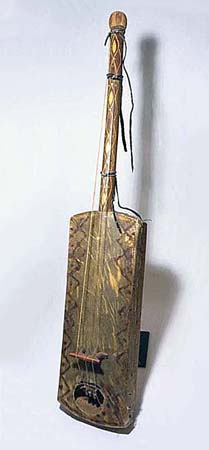
Owner: HWMC
Catalog#: 2AF-CHLT-03
Lutes
Gnawa “sintir”
Morocco and Algeria
Gnawa
Camel skin, goat strings, wood
Early 20th Century
Length: 38 in; Width: 7 in; Depth: 4.75 in
Chordophones – Lutes – Strummed / Plucked
This low-pitched, three-string, skin-covered bass plucked lute is mainly found to Morocco and Algeria, where it is used by the Gnawa people. Sometimes it is referred to as the “guembri” or “gimbri.” It supports singers along with rhythmic clapping and “krakeb” (clappers), and at times it aids ritual trance induction.
The Gnawa people are the residents of Kano, the capital of the Hausa-Fulani Emirate, which was under Morocco influence. Gnawa music is a body of Moroccan and sub-Saharan African Islamic religious songs and rhythms. Its well-preserved heritage combines ritual poetry with traditional music and dancing. The music is performed at Lila, communal nights of celebration dedicated to prayer and healing guided by the Gnawa maalem, or master musician, and their group of musicians and dancers.
Gnawa music is characterized by instrumentation. The large, heavy iron castanets known as qraqab or krakebs and a three-string lute known as a hajhuj, gimbri, or sentir, are central to Gnawa music. The hajhuj has strong historical and musical links to West African lutes like the Hausa halam, a direct ancestor of the banjo.
Gnawa have venerable stringed-instrument traditions involving both bowed lutes like the gogo and plucked lutes like the hajhuj. The Gnawa also use large drums called tbel in their ritual music.
The Gnawa People can be found in Morocco, Algeria and some parts of Libya. They are part of the Berber ethnic group and related to the Maghreb (Northwestern Africa) People of Morocco. The Gnawa have adopted Islam which is practiced by the majority of Gnawa in their traditional music that combines Islamic sufism and African traditions.
